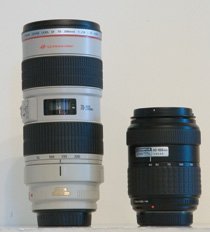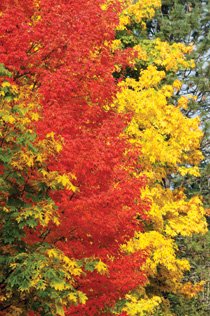Telephoto Lenses
| For some reason, almost everyone starting out in photography wants a big telephoto lens. Are we compensating for some inadequacy? Probably not, but they look darn impressive and lend a professional look to the photographer carrying one around in the field (Figure 3.19). Figure 3.19. A telephoto lens, like this Canon 500mm, is ideal for capturing wildlife, but it's also useful in other types of photography.
Telephoto lenses are any lenses with focal length over 90mm, going as high as 1000mm, although the most common sizes are 300mm and under, with a lens in the 200mm range being the most popular. Where a wide-angle lens exaggerates the foreground and gives you a wide focus range, telephoto lenses compress objects and make them look closer together (Figure 3.20). Figure 3.20. Using a telephoto lens allows you to compress distant subjects, making them look closer together, like these trees which were actually a good distance apart from each other.
A telephoto lens also has less depth of field at the same aperture than a shorter lens does, making focusing more critical and difficult. But, when you need the reach for a bird or animal that you can't or don't want to approach, nothing beats a big telephoto lens. Most telephoto lenses are slower, with apertures of f/5.6 common in consumer-level lenses to keep the price and size down, meaning they are not great for low-light photography. As an example of the difference, consider two different Canon 400mm lenses. The EF 400 f/5.6 L is a fantastic lens that uses Canon's top optical glass and construction. This lens sells for about $1,100. The lens is 10 inches long and weighs about 2.8 pounds. The EF 400 f/2.8 gives you two more stops of aperture, or four times the light-gathering ability, but increases the size to 14 inches and 6.4 pounds. Oh, and the price? It jumps a bit as well, to $6,600. |
EAN: 2147483647
Pages: 91

